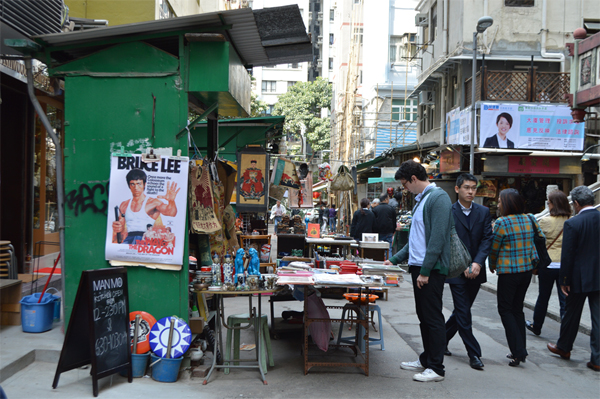The Way of the Dragon: A Hong Kong Screening (10.27.2013)
By Jenn Gresham

One need not look very far before encountering Bruce Lee’s image amidst the bustling streets and terraced cityscapes of Hong Kong. It can be found on the original movie posters and film pamphlets sold alongside Chairman Mao collectibles and antique Buddhas on Sheung Wan’s Upper Lascar Row, on the colourful kung fu T-shirts for sale in Stanley Market, and on book covers adorning display tables at Page One, Eslite, Dymocks, and Swindon’s. Along the Avenue of Stars in Tsim Sha Tsui, a bronze memorial statue of Lee stands at the harbour’s edge against a spectacular backdrop of mountain, city, and sea—its form, though fixed firmly and forever in place, mysteriously conveying a sense of motion, like a freeze frame of a movement about to be carried forward in time. In light of both his lasting local and global cultural resonance and the four-decade milestone of his passing, I was therefore not surprised to learn that the Hong Kong Film Archive would be celebrating UNESCO’s World Day for Audiovisual Heritage on October 27th by screening a new print of The Way of the Dragon (1972), Lee’s sole completed directorial effort.
Pleasantly nestled in a quiet corner of Sai Wan Ho since its opening in 2001, the Hong Kong Film Archive’s modern exterior and modest size belie its cultural significance as both guardian and purveyor of the city’s rich cinematic past. On the day of the screening, the ground floor of the building houses a special exhibition, Merry-Go-Movies, dedicated to Hong Kong’s child stars. Among the young faces represented in the old black and white stills on display is that of Bruce Lee, whose precocious first lead role as the protagonist of 1950’s The Kid had recently been screened at the Archive along with two other of the actor’s early works, A Son is Born (1953) and An Orphan’s Tragedy (1955).
What the Hong Kong Film Archive lacks in size, it makes up for in its programming and general atmosphere. Expectant moviegoers mill about and loiter at leisure, thumbing the pages of the most recent edition of the Archive’s beautifully produced Profolio booklet and perusing informative photographic displays on Chinese film history or beloved screen icons of bygone eras. On this day, there is a noticeable excitement in the air as well as a sense of community, the audience bound together in their common appreciation of the artistry and skill of Hong Kong’s own Little Dragon, who—in his hybrid identity, fusion of styles, and spirit of transformative overcoming—functions as metonym and symbol of the city itself.
Though I have seen The Way of the Dragon several times before, the context of this viewing—in a Hong Kong theater forty years after Lee’s death—immediately transforms my experience of the film. The audience response forms a kind of parallel text in relation to the narrative on the screen, enabling me to interpret it anew. They laugh uproariously when Lee orders five bowls of soup in an airport restaurant in Rome and when he inquires if Italians celebrate the Lunar New Year—a laughter, incidentally, that also accompanies his most dominant feats of strength—and I wonder why I had never before interpreted the film as a comedy of cultural displacement.
I watch, fascinated, as the little boy in the seat ahead of me is progressively hypnotized by the image of Bruce Lee. Though he must cavort gymnastically in his chair and occasionally stand on his feet in order to see between the heads of the couple in the row ahead of him, his attention never wavers. In some of the early fight scenes he is possessed by a mimetic impulse so powerful that it simply cannot be contained. And yet when Bruce Lee faces Chuck Norris in the climactic fight sequence in the Roman Colosseum—which strikes me, for the first time, as an allusion to Theseus and the Minotaur—the boy sits as still as stone. In the film, the only spectator to this mythic battle is a tiny kitten, and my mind briefly alights on the relation between the kitten and the boy. Only when Lee respectfully covers Chuck Norris’s lifeless body with the dead man’s uwagi does the boy finally allow himself to breathe.
As Bruce Lee recedes alone into the distance in the final shot of the film, the theater lets out a collective sigh. Four decades after his death, the man who was already delighting viewers at the age of ten with his comic antics in The Kid continues to have a cathartic impact on his audiences around the world, but especially here in Hong Kong, a city committed to the preservation of his art and inscribed—in film and in living memory—with his indelible image.

Our apologies, you must be logged in to post a comment.